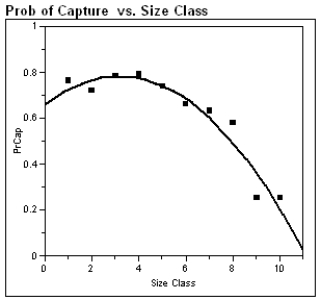A common statistical method for estimating a population size assumes each member of the population has an equal probability of being captured. To assess this assumption for crocodile populations, investigators repeatedly sampled sections of rivers in Australia. Crocodile lengths were measured in size classes. Crocs 0.0 - 0.3 meters in length are in size class 1, 0.3 - 0.6 meters in length are size class 2, etc. The normal maximum adult length is in a class size of 9 or 10. The investigators fit a quadratic function relating the probability of capture and the size class of captured crocodiles. The output from their analysis is shown below. 

(a) What proportion of the variability in probability of capture is explained by the crocodile's size class?
(b) Some biologists speculate that as crocodiles grow they become more wary of humans, and are more difficult to detect in the wild. Support or refute this belief by appealing to the analysis above.
Correct Answer:
Verified
b) This belief ap...
View Answer
Unlock this answer now
Get Access to more Verified Answers free of charge
Q20: The slope of the least squares line
Q21: If a correlation coefficient r is close
Q22: Polar bear cubs are born in the
Q23: The Des Moines Register recently reported the
Q24: A cause-and-effect relationship between two variables is
Q26: An ice cream seller wants to predict
Q27: The data below were gathered on a
Q28: One of the problems when estimating the
Q29: The correlation coefficient between the consumption of
Q30: Assessing the goodness of fit of a
Unlock this Answer For Free Now!
View this answer and more for free by performing one of the following actions

Scan the QR code to install the App and get 2 free unlocks

Unlock quizzes for free by uploading documents